Air Forces
in the
Vietnam War
Each of the combatants utilized air power, but the United States
ruled the skies. The American pilots often were the major factors that
turned the fortune of battles. They bombed North Vietnam into rubble.
They interrupted enemy supply lines and communications. They strafed and
bombed enemy troops in the heat of the ground war. These activities were
a repeat of World War 2 and Korean War strategies. Despite the overwhelming success, it did not produce victory.
Vietnam
air tactics broke the prior mold. Added to their duties were close air
support for American ground forces, jungle defoliation, elimination of
crops, side gun operation, air lifting the wounded from the battlefield,
rescue of downed pilots and front line observation for the artillery.
Little wonder that they flew over 5 million sorties. Although each life
was precious, the loss of 2586 airmen were surprisingly light given the
number of flights and the variety of combat duties. It was a testament to
their skills and courage.
During the French colonial occupation after World War
2, America furnished an array of fixed wing, propeller operated bombers
and fighters to the French.. When they were forced to retire from
Indochina after their defeat at Dien Bien Phu (1953), they
"bequeathed"
their American supplied air force to the South Vietnamese. Training
would fall on the shoulders of the United States. The earliest planes to
reach Vietnam were propeller driven. Jet planes would soon join the
war.
Hardly had the ink dried on the 1954 Geneva Accords that divided Vietnam into two spheres of influence and control, the United States began funneling military equipment to the government in the south. Despite the best efforts of military advisers, the good equipment was badly utilized.
The American response to the Gulf of Tonkin attack was Operation Rolling Thunder. It was President Johnson's answer to increased VC attacks on Americans. He would occasionally choose the target. The Constitution made him the Commander in Chief and he readily assumed the role-- one he probably regretted. The major air response began on March 3, 1965. It would run over three years subject to the president's occasional stop and go policy based on the false hope of imminent peace.
Rolling Thunder began with the United States Air Force (USAF) bombing the area 10 miles north of the demilitarized zone (DMZ). The intent was to give the North a taste of worse to come. Over 100 unescorted, supersonic F-100s primary target was a North Vietnam ammo depot. Six of the fighter bombers were shot down with the loss of only one pilot who was imprisoned until 1973.
This three year operation was halted October 31, 1968 and the score card listed 900 of these planes lost. The lesson learned by the USAF was the significance of escort fighters. A lesson that apparently was forgotten from the World War 2 experience. When they were heavily laden with bombs they were vulnerable to the Russian Mig-21s. Retaliation was on the horizon.
Air forces in the Vietnam war
Fixed - Wing
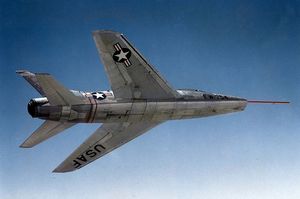
At the same time that the F100s were over the north, the South Vietnam air force ordered 60 of its propeller operated planes to drop bombs on a naval base in the north.The pre -jet planes were quite efficient and easy to fly.
Early in 1965,the Douglas A-1 Skyraider was a single engine attack bomber considered as one of the most reliable in Vietnam. It was noted for its accuracy in close ground support. It operated at 320 MPH with a range of 1200 miles. A squadron based at Danang led the first strike in North Vietnam. The plane was also a standard in the South Vietnam air force.
Over the course of the war, the USAF lost 150 in combat. The first loss was in 1964 and the last, 1972. Their brother services also used the A-1. The Navy lost 48 Raiders and the Marines lost 81. Air forces in the Vietnam war
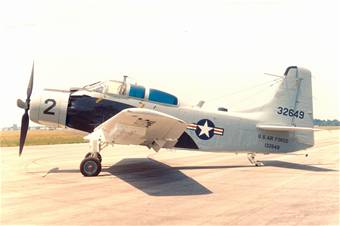
On January 1967, a plan was hatched to draw the Vietnam Peoples Air Force (VPAF) into a fight with the stronger U.S. Phantom F-4 fighters. The Mig-21 interceptors were duped into believing they would be attacking the less dangerous F105s. Twenty-six Phantoms were each equipped with 8 air to air missiles. The U.S. planes shot down 7 VPAF Mig-21s. The North received the Mig -17 from the Soviet Union its principal supply source.. it was an upgraded jet refitted from the Korean War M-15. It had an array of heavy fire power and was very maneuverable. The Mig-21 was a further upgrade. It was a high speed, delta wing interceptor. It had the potential of a first class opponent to the Phantom. However,not in January 1967.
382 Phantoms were lost in combat over the course of the war. The first shot down occurred on June 20, 1965.
The Phantoms were produced by McDonnell Douglas and believed to be the best fighter in Vietnam. The U.S. Navy and the Marines also used the F-4. The Marines lost 95 in combat. Their next heaviest losses were the Douglas Skyraider losing 81 in battle. (Statistics do not include destruction from accidents.)
Air forces in the Vietnam war
Air forces in the Vietnam war
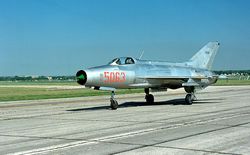 |
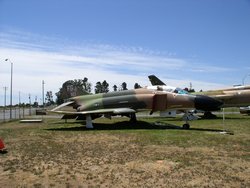 |
Air forces in the Vietnam war
Vietnam was a proving ground for U.S. aircraft. There was a constant evolution of models and transitioning to completely new designs. Illustrative is the history of the Douglas B-26 Invader. It saw duty in world war II and well into the 1960s in Vietnam. This airplane was stationed at an air force base in Thailand. The twin engine light bomber was considered easy to fly, but prone to accident. It was replaced by the Douglas A-1 Skyraider (above), a single seat, piston engine that was used by the USAF and the Navy. This propeller plane had 2 "kills" against the jet Mig - 17 (Mikoyan - Guarvich). The A-1 was replaced by the A-7 Corsair, and in turn served with the Douglas A-4 Skyhawk, the longest manufactured in the war. The A-4 had been part of the air arsenal since the 1950s. It suffered its first loss over Vietnam in August 1964 and lost 150 in combat. The A-7 Corsair, remained in operation through 1973. It was a work horse for the navy and suffered the first combat loss by rocket fire (SAM) on December 22, 1967. They lost a total of 55 aircraft, and the first loss from the air craft carrier, USS Ranger.
.The U.S. Navy lost 195 A-4s. The first loss off the carrier U.S. Constitution, was in August 1964 by AA ground fire.
The USAF flew 40 different model upgrades or designs. The U.S. Navy used 7 variations and designs similar to those flown by the USAF..
Air forces in the Vietnam war Air forces in the Vietnam war
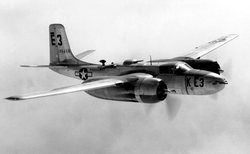 B-26 1966 A-1 Skyraider 1967 A-4 Skyhawk Air forces in the Vietnam war |
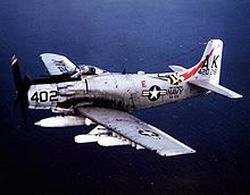 |
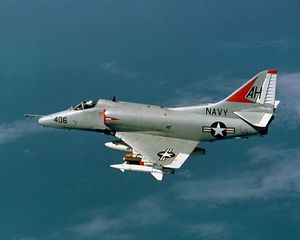
The Martin B-57B was the first American jet introduced in the Vietnam War. Actually, identical to the English Canberra and manufactured in America under that license. The United States flew 38,000 sorties with this aircraft and was also used by the South Vietnam ally. It had an extra large bomb capacity and reportedly feared by the Viet Cong. Air forces in the Vietnam war
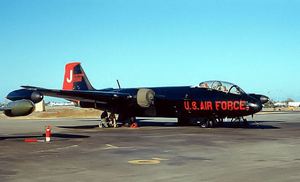
The Thunderchief 105D was used extensively in the early years of the war. This was a mach 2 fighter-bomber that flew over 20,000 sorties with over 20 "kills". However their heavy casualty rate (almost 300 in combat) gave them the rare distinction as the only bomber withdrawn from the theater because of that reason. . Their size cut down on agility. As a result, they were targeted by PVAF Migs.
Shot down over North Vietnam. Air forces in the Vietnam war
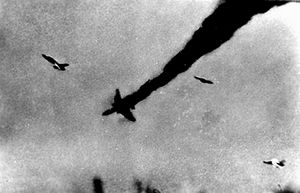
In June 1965, the Boeing B-52 made its appearance over Vietnam. They used bases in Thailand and Guam. This bomber, Superfortress, carried a bomb load up to 70,000 pounds, and operated at 30,000 feet. They were capable of carrying nuclear missiles. 17 planes were lost in combat. 15 were lost in the Linebacker II campaign on December 18, 1972. This operation ran for 12 days and flew 729 sorties. 15,000 tons of bombs fell on the North Vietnam capital, Hanoi, and on the their principal harbor at Haiphong.
A squadron of 6 could completely level a targeted area of over 1/2 mile swath.
General Nathan Twining, Air Force Chief of Staff:
"---Today this B-52 is the long rifle of the air age".
Two unusual air to air "kills' are recorded describing the actions of two tail gunners downing two Migs with their 50 caliber machine guns.
Their bombing was incessant during the entire course of the war. They also engaged in carpet bombing over jungle areas. The range of actions covered from the south of Vietnam to the northern border of North Vietnam.
Air forces in the Vietnam war
The USAF Lockheed C-130 Hercules was a highly efficient, many purposed aircraft. The initial design was the beginning of 8 future evolutions. It started as a troop carrier and supply transport. It would be used as a gun ship and for rescue. Despite its size, it could land and take-off from aircraft carriers and supported marine actions into combat. It could take a punch from ground fire and survive. Air forces in the Vietnam war
Air forces in the Vietnam war
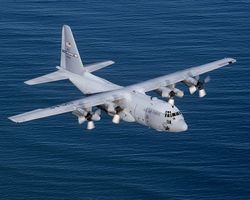 Deck of USS Forrestal |
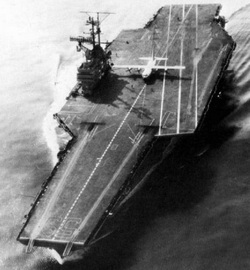 |
Unique Bomb Loads
Napalm: This was an incendiary bomb that was a weapon of terror. Dow Chemical prepared a compound of a gasoline jell containing polystyrene, gasoline, benzine. It burned up to 15 minutes at a flesh melting 850 degrees centigrade. The burn area covered 200 meters by 30 meters wide. The bomb weight was from 250 pounds to 750 pounds. At the end of World War II, it was used as though it were a flame thrower.
Death was either by burning or asphyxiation. The authenticity of this iconic photo was disputed by President Nixon. It was inflammatory and incited protests. Napalm used by South Vietnam Air Force to dislodge NVA from Treng Bang (June 8, 1972). Air forces in the Vietnam war
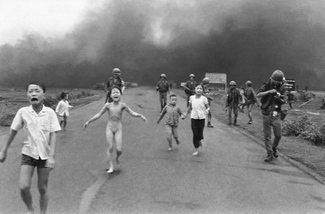
Agent Orange (Employed in Operation Ranch Hand 1961-1972): Used to deny the enemy the cover of heavy jungle. It was a herbicide containing the chemical dioxin, but 50 times stronger. It caused hundreds of thousands of deaths and birth defects. It affected Americans exposed to the chemical and may be a carcinogen. It was later determined to be a violation of the Geneva agreements.The United States discontinued the defoliant in 1971.
The spray was used from the air, from boats and ground vehicles. In the air, the C-23 was the principal operator. Air forces in the Vietnam war
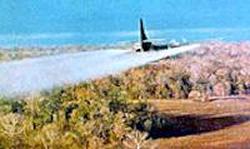 |
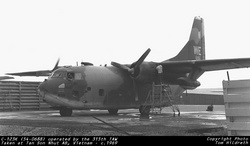 |
Smart Bomb: the target was struck with great accuracy by a precision guided munition (pgm) and a pulsed laser beam was used to illuminate the target. Then the light source was located by a seeker system on the bomb or missile. Its utilization was minimal in Vietnam and little used until May 13, 1972 when it hit a bridge that had been an elusive target for 800 prior sorties. One problem was its ineffectiveness in bad weather that muted illumination necessary to pinpoint the target.The Navy A-6 dropped the smart bomb on power plants in North Vietnam.
Dumb Bomb: The munition, by default, was either standard or cluster type. The former was effective against fortified bunkers and in heavy jungle. The cluster was utilized extensively by the B-52. It was particularly effective against gound troops when used for anti personnel and anti armor (fragmentation) destruction. White phosphorous and smoke were part of the bomb arsenal.
Daisy Cutter: Enter in 1970 a 15,000 pound bomb with twice the power of TNT. The bomb's destructive radius was 1200 feet.
Rotary Operated Aircraft
Air forces in the Vietnam war
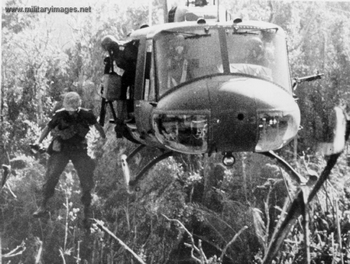
Vietnam is fittingly referred to as the "helicopter war". The role of air power, particularly in South Vietnam was to support ground campaigns. The helicopter was particularly adept to fulfill this role. It was unusually mobile, it moved troops in and out of battle areas expeditiously and a life saver in moving the wounded to safe hospitals for immediate treatment. It was also an offensive weapon capable of routing a regiment with its fire power.
Added to its resume, was its ability to move troops who would otherwise be exposed on roads. The helicopters were quick in aiding Americans caught in ambushes.
However, they could be extremely vulnerable to enemy fighter craft. Enter the fixed wing U.S. air power that swept away that danger, but it did not eliminate it from the ground. In the early years of the '60s, the enemy VC and the northern PAVN were short on anti aircraft weapons. That would change over time, and the U.S. Army losses of rotary wing craft were well over 4,000.This count excludes the rotary craft of the other services.The Marines lost about 300 and the USAF losses were about 100.
The Bell UH-1H (Huey) Iriquois pictured above was a front line offensive weapon and the work horse of the U.S. Army. They were deployed from the Tan Son Nhut airport that serviced Saigon. The losses were high. 3,305 were shot down with losses of over 2,000 pilots and crew.
The Army had 25 rotary types. Essentially all operated with piston shaft engines and 2 tail rotary and tail blades.The Huey was well stocked.. They usually carried rocket and grenade launchers and machine guns.The well armed copters provided fire power for the troop carriers inserting ground forces.
The Marines operated only 6 models and its heaviest losses , similar to the army, were UH Hueys. However, their personal favorite was the Sikorsky CH-34 Choctau. This gun ship carried two M60C machine guns and two 19 shot rocket pods. They were particularly active over (and in ) the Mekong Delta in 1965. The Marines used the Choctau in the first night assault in August 1965 when they inserted ground forces north of Da Nang.
Air forces in the Vietnam war
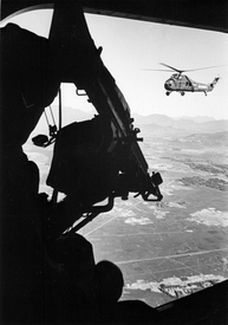
The USAF had a huge inventory and variety of fixed wing aircraft. Not so with their rotary-wing craft. They employed 3 basic models. Their Super Jolly Green Giant, style borrowed from the Marine's CH 53 Sea stallion, was the high tech of helicopters. It was the largest and could carry 37 armed troopers as well as manned by 2 pilots, 2 engineers and 2 gunners. They carried a sonar system that warned of terrain to be avoided. Their GPS solved navigation problems, and they they could refuel inflight. They were particularly adept in resupplying special forces.
They received public attention in November 1970 when they unsuccessfully attempted to extract American POWS from the Son Tay prison camp in North Vietnam.
They carried three 7.62mm miniguns and Browning side mounted machine guns. Air forces in the Vietnam war
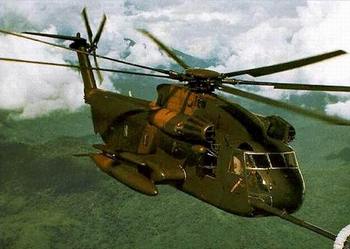
In 1961, the south was supplied with the Piasecki Shawnee CH-21. In December the ARVN were the first to airlift paratroops into combat by helicopter. This rotary operated helicopter was later rejected by U.S. forces as unreliable. Although, they were utilized in the early years to evacuate casualties.
Each medivac copter carried a trained medic and medical lifesaving supplies. The medivacs were particularly adept in heavy jungle rescues.
The Sikorsky CH-54 "Sky Crane" was essential in the resupply of the outer bases. Without this support, there was no way to safely transport heavy equipment overland. The heavy lifting included large artillery pieces. This role was also the job of the Boeing Chinook CH-47.
Air forces in the Vietnam war CH-54 CH-47 Air forces in the Vietnam war
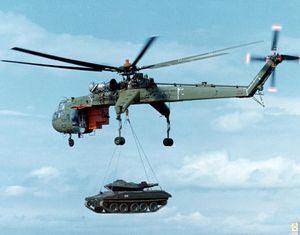 |
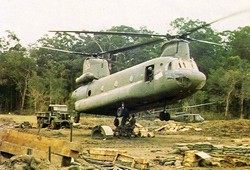 |
The United States ruled the skies over Southeast Asia and, nevertheless, could not win the war with that superiority. The Washington (President Johnson and Defense Secretary McNamara) directed strategy of restricted bombing, the understandable anxiety over the possibility of China and/or the Soviet Union entering the war, and the loss of public support contributed to a lost war. There were also the weakness and corruption of the South Vietnam governments, propped up by the United States, that attracted their public's sentiment toward the ideology of the North. Lastly, the goal of a united Vietnam, under communist rule, was inevitably accomplished by the dogged determination of the enemies foot soldiers to complete that mission.
Air forces in the Vietnam war
______________________________________________________________
References and Sources: